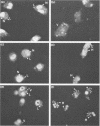Abstract
We have studied the ability of poly-2-vinylpyridine-N-oxide (PVNO), a lysosomal stabilizing agent, to abrogate the cytotoxic effects of silica on macrophages. Male C3H/HeN mice were pretreated with PVNO and inoculated intravenously with silica particles. At 24 h after silica injection, silica-treated and -untreated mice were challenged intravenously with varying doses of live yeast cells of Histoplasma capsulatum. All mice receiving silica died when challenged with 5 X 10(5) yeast cells of Histoplasma sp. compared with no deaths in PVNO-pretreated animals and 10% mortality in controls not receiving PVNO or silica. When animals were given 2.5 X 10(5) yeast cells (a sublethal dose), the protective effect of PVNO was seen by a reduction in splenomegaly and viable Histoplasma sp. present in the spleen. Furthermore, PVNO alone showed a significant protective effect (P less than 0.05) against a lethal challenge with Histoplasma sp. Prior treatment with PVNO also protected mouse peritoneal macrophages from the cytotoxic effects of silica particles in vitro. These results indicate that PVNO abrogates the cytotoxicity of silica particles on macrophages and also increases the resistance of mice to histoplasmosis.
Full text
PDF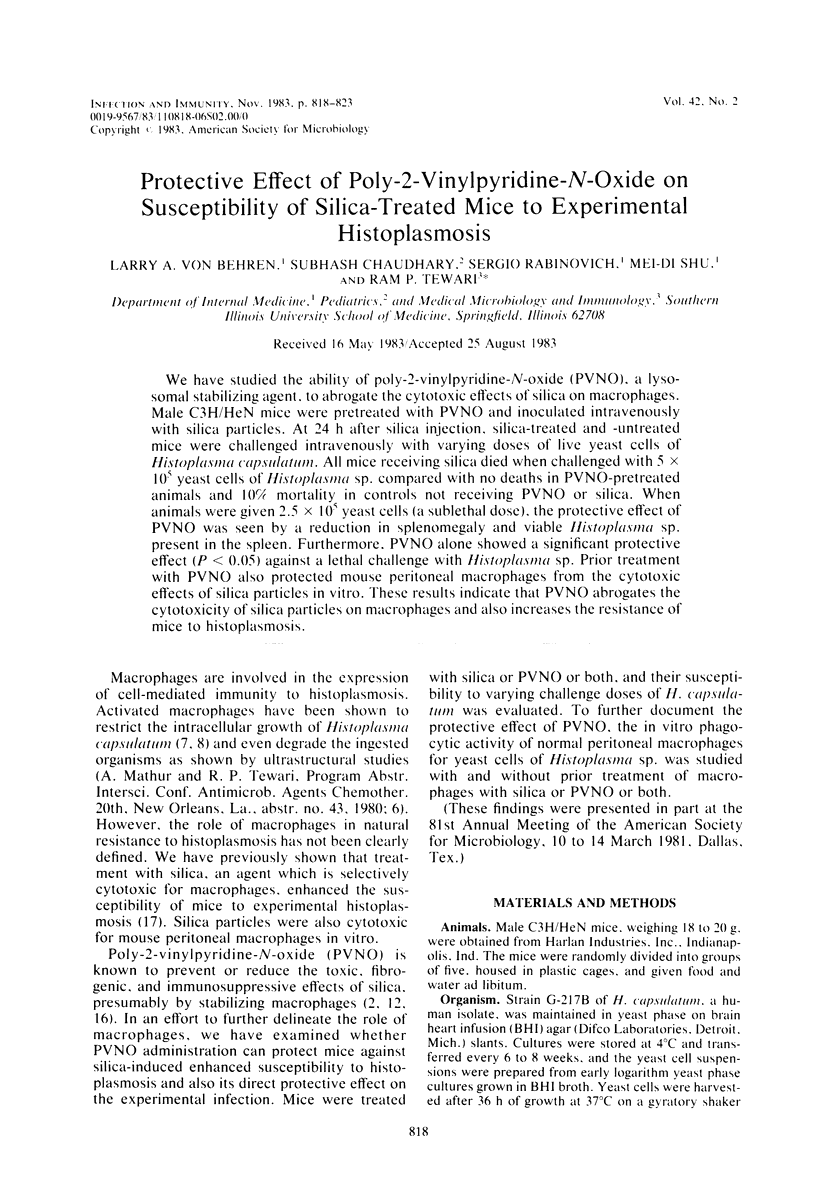
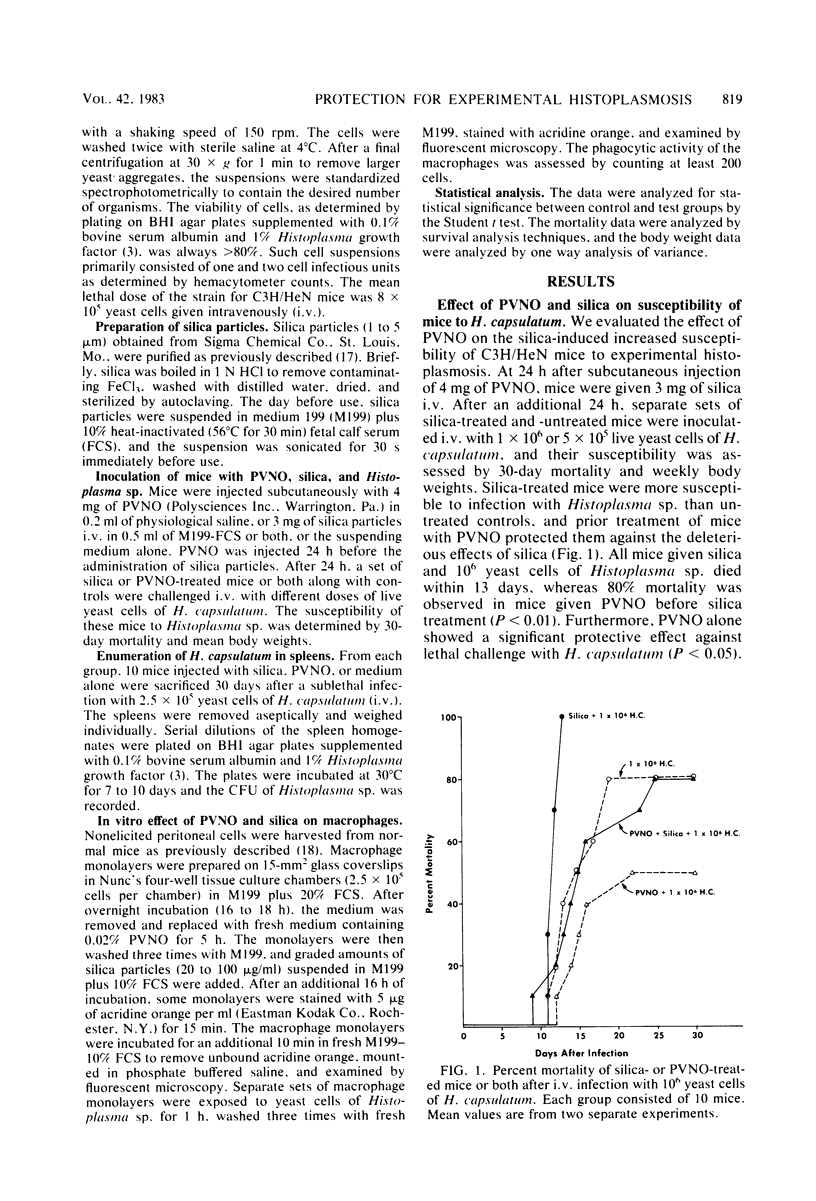
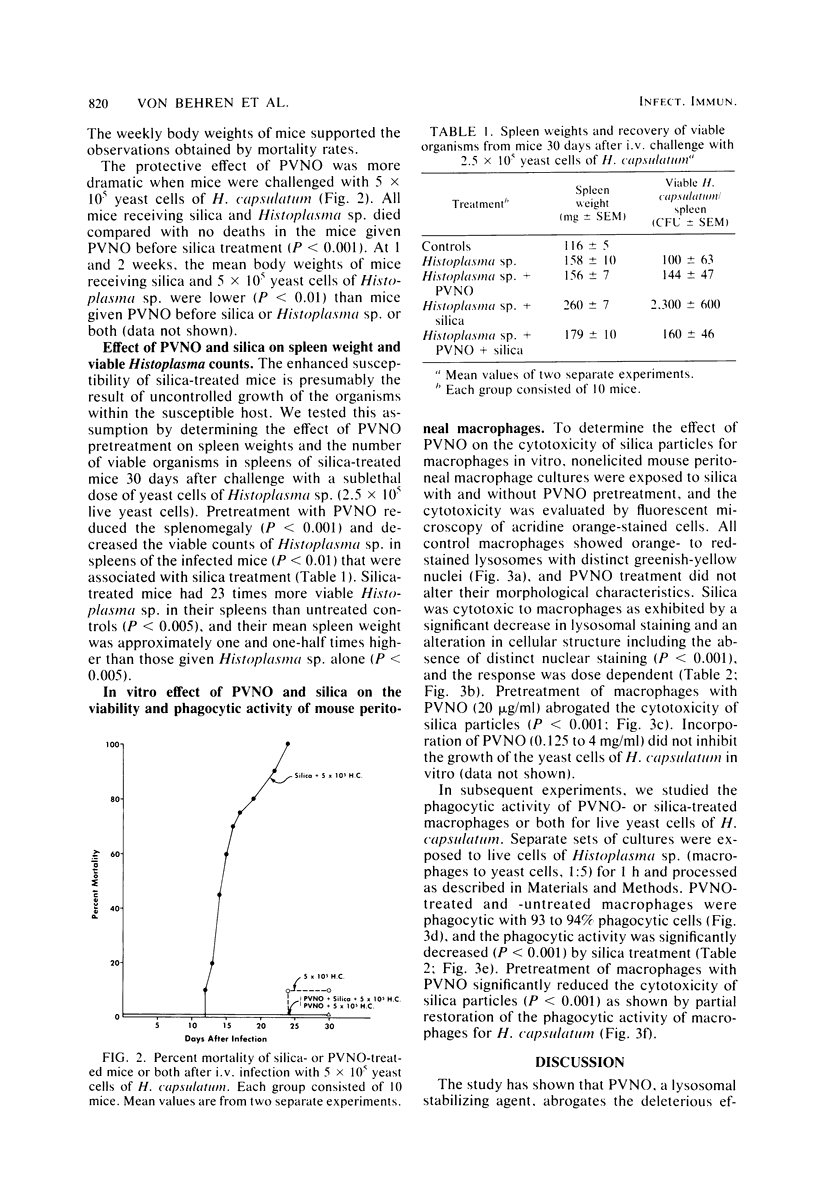
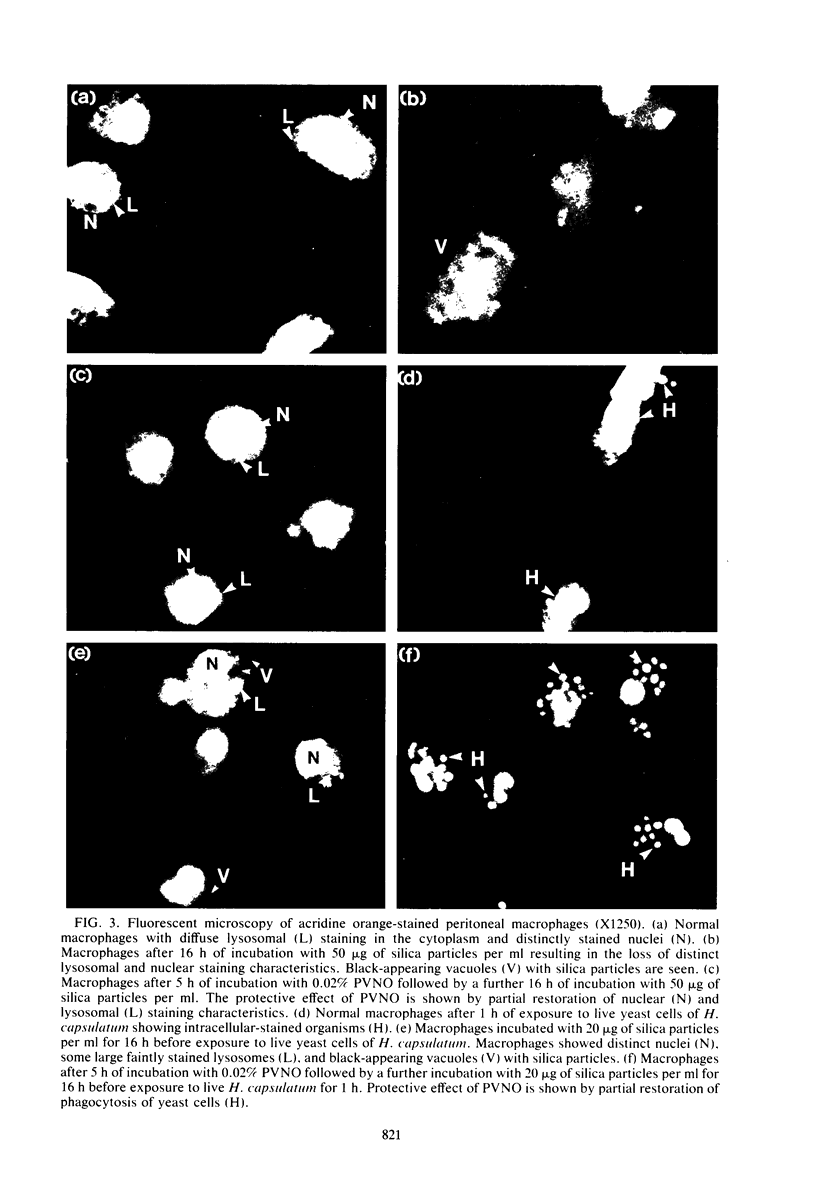
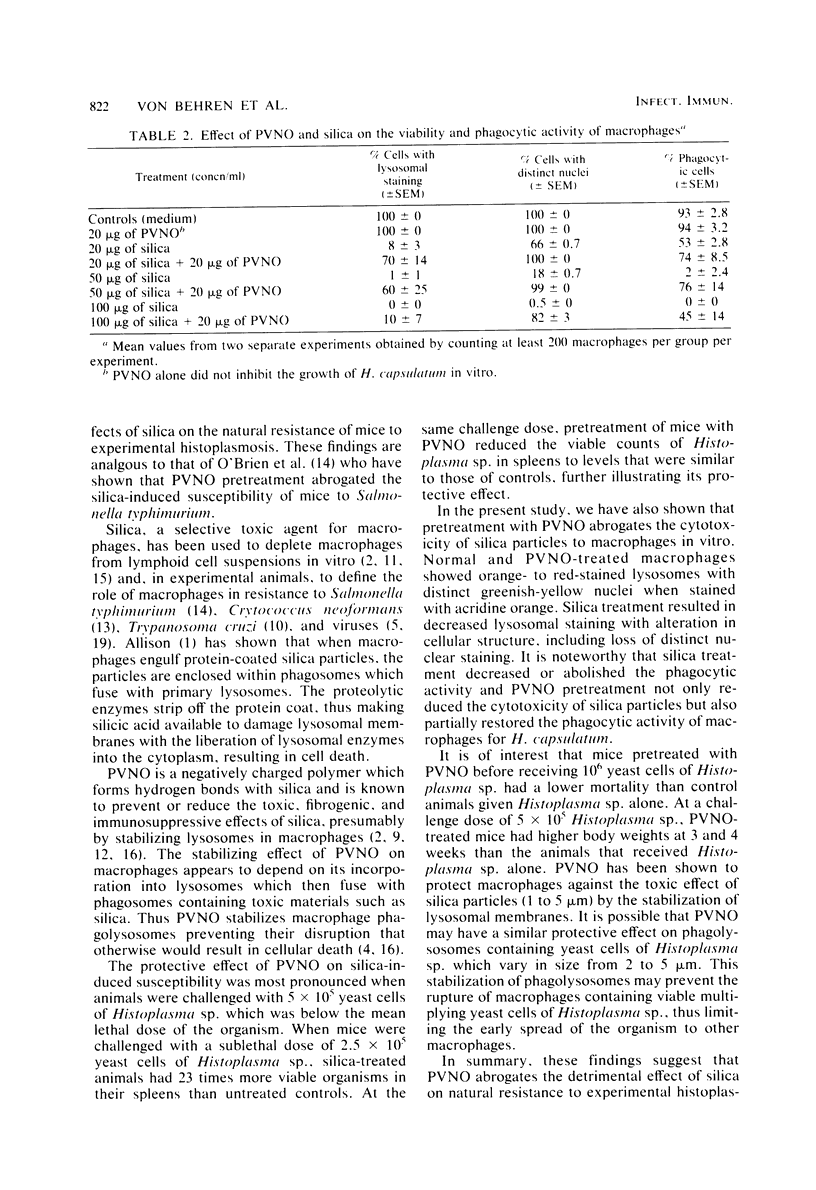
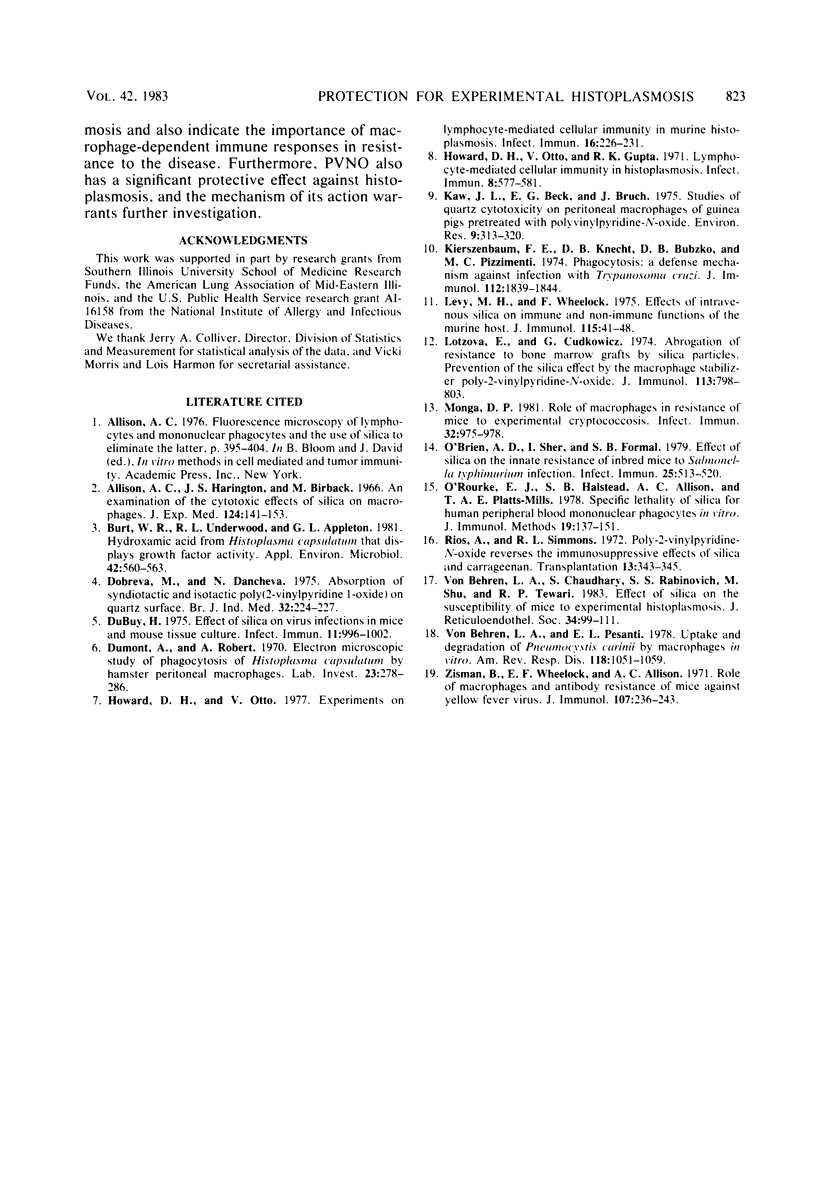
Images in this article
Selected References
These references are in PubMed. This may not be the complete list of references from this article.
- Allison A. C., Harington J. S., Birbeck M. An examination of the cytotoxic effects of silica on macrophages. J Exp Med. 1966 Aug 1;124(2):141–154. doi: 10.1084/jem.124.2.141. [DOI] [PMC free article] [PubMed] [Google Scholar]
- Burt W. R., Underwood A. L., Appleton G. L. Hydroxamic acid from Histoplasma capsulatum that displays growth factor activity. Appl Environ Microbiol. 1981 Sep;42(3):560–563. doi: 10.1128/aem.42.3.560-563.1981. [DOI] [PMC free article] [PubMed] [Google Scholar]
- Dobreva M., Dancheva N., Holt P. F. Adsorption of syndiotactic and isotactic poly(2-vinylpyridine 1-oxide) on quartz surface. Br J Ind Med. 1975 Aug;32(3):224–227. doi: 10.1136/oem.32.3.224. [DOI] [PMC free article] [PubMed] [Google Scholar]
- Dumont A., Robert A. Electron microscopic study of phagocytosis of Histoplasma capsulatum by hamster peritoneal macrophages. Lab Invest. 1970 Sep;23(3):278–286. [PubMed] [Google Scholar]
- Howard D. H. Further studies on the inhibition of Histoplasma capsulatum within macrophages from immunized animals. Infect Immun. 1973 Oct;8(4):577–581. doi: 10.1128/iai.8.4.577-581.1973. [DOI] [PMC free article] [PubMed] [Google Scholar]
- Howard D. H., Otto V. Experiments on lymphocyte-mediated cellular immunity in murine histoplasmosis. Infect Immun. 1977 Apr;16(1):226–231. doi: 10.1128/iai.16.1.226-231.1977. [DOI] [PMC free article] [PubMed] [Google Scholar]
- Kaw J. L., Beck E. G., Bruch J. Studies of quartz cytotoxicity on peritoneal macrophages of guinea pigs pretreated with polyvinylpyridine N-oxide. Environ Res. 1975 Jun;9(3):313–320. doi: 10.1016/0013-9351(75)90011-0. [DOI] [PubMed] [Google Scholar]
- Kierszenbaum F., Knecht E., Budzko D. B., Pizzimenti M. C. Phagocytosis: a defense mechanism against infection with Trypanosoma cruzi. J Immunol. 1974 May;112(5):1839–1844. [PubMed] [Google Scholar]
- Levy M. H., Wheelock E. F. Effects of intravenous silica on immune and non-immune functions of the murine host. J Immunol. 1975 Jul;115(1):41–48. [PubMed] [Google Scholar]
- Lotzová E., Cudkowicz G. Abrogation of resistance to bone marrow grafts by silica particles. Prevention of the silica effect by the macrophage stabilizer poly-2-vinylpyridine N-oxide. J Immunol. 1974 Sep;113(3):798–803. [PubMed] [Google Scholar]
- Monga D. P. Role of macrophages in resistance of mice to experimental cryptococcosis. Infect Immun. 1981 Jun;32(3):975–978. doi: 10.1128/iai.32.3.975-978.1981. [DOI] [PMC free article] [PubMed] [Google Scholar]
- O'Brien A. D., Scher I., Formal S. B. Effect of silica on the innate resistance of inbred mice to Salmonella typhimurium infection. Infect Immun. 1979 Aug;25(2):513–520. doi: 10.1128/iai.25.2.513-520.1979. [DOI] [PMC free article] [PubMed] [Google Scholar]
- O'Rourke E. J., Halstead S. B., Allison A. C., Platts-Mills T. A. Specific lethality of silica for human peripheral blood mononuclear phagocytes, in vitro. J Immunol Methods. 1978;19(2-3):137–151. doi: 10.1016/0022-1759(78)90174-6. [DOI] [PubMed] [Google Scholar]
- Rios A., Simmons R. L. Poly-2-vinylpyridine N-oxide reverses the immunosuppressive effects of silica and carrageenan. Transplantation. 1972 Mar;13(3):343–345. doi: 10.1097/00007890-197203000-00026. [DOI] [PubMed] [Google Scholar]
- Von Behren L. A., Chaudhary S., Khardori N., Rabinovich S., Shu M. D., Tewari R. P. Effect of silica on the susceptibility of mice to experimental histoplasmosis. J Reticuloendothel Soc. 1983 Aug;34(2):99–111. [PubMed] [Google Scholar]
- Von Behren L. A., Pesanti E. L. Uptake and degradation of Pneumocystis carinii by macrophages in vitro. Am Rev Respir Dis. 1978 Dec;118(6):1051–1059. doi: 10.1164/arrd.1978.118.6.1051. [DOI] [PubMed] [Google Scholar]
- Zisman B., Wheelock E. F., Allison A. C. Role of macrophages and antibody in resistance of mice against yellow fever virus. J Immunol. 1971 Jul;107(1):236–243. [PubMed] [Google Scholar]
- duBuy H. Effect of silica on virus infections in mice and mouse tissue culture. Infect Immun. 1975 May;11(5):996–1002. doi: 10.1128/iai.11.5.996-1002.1975. [DOI] [PMC free article] [PubMed] [Google Scholar]



